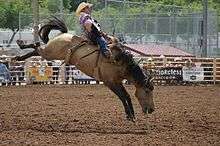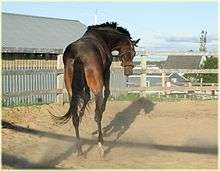Bucking

Bucking is a movement performed by a horse or bull in which the animal lowers its head and raises its hindquarters into the air, usually while kicking out with the hind legs. If powerful, it may unseat the rider enough to fall off.
Reasons for bucking


Bucking, though a potentially dangerous disobedience when under saddle, is a natural aspect of horse behavior. It developed in the wild for the purpose of protection from feline predators such as mountain lions, who would attack horses by dropping onto their backs from above. The process of kicking out with both hind legs, another defense mechanism for the horse, also results in a mild bucking movement. Thus, for a human to safely ride a horse, the horse has to be desensitized to the presence of something on its back and also learn not to kick out with both hind legs while under saddle. Nonetheless, because the instinct is always there, bucking can still occur for a number of reasons:
- Happiness, such as when a horse bucks during a gallop because of enjoyment, or during play.
- General excitement, such as horses that buck in a crowded schooling ring or at the beginning of a ride in a crowd of horses, such as an endurance ride.
- The rider's aids are causing confusion or fear in the horse, and the horse responds by bucking.
- The horse is "fresh," having been kept up in a stall for a long period of time, and is releasing pent-up energy.
- Pain, which may be due to an ill-fitting saddle or another piece of equipment, tooth problems, or other medical issues.
- Provocation, usually due to an insect bite (usually on the hindquarters) which the horse is trying to rid himself of, or in some cases a response to use of a whip on the flank or hindquarters.
- Untrained horses may instinctually buck the first few times they have a saddle on the back if not given proper ground training, and occasionally, even with proper preparation. This is an instinctive defense mechanism.
- Having found that bucking the rider off results in not having to work, the horse does it to avoid his exercise.
- Disobedience to the riding aids, when a horse does not wish to do what is asked by the rider. Sometimes this is due to poor riding on the part of the person, but sometimes a horse attempts to evade a legitimate request by bucking.
- Rodeo broncs are used specifically as bucking horses, usually bred to be prone to bucking and encouraged to buck whenever a rider is on their back with the help of a "bucking strap" around their flank.
- Fear of loud and noisy machines, like cars, trucks, trains, and planes. In response to the tragic injuries that have resulted, the American courts have uniformly held that "the needs of a modern, industrial society often conflict with and generally must prevail over the delicate sensibilities of horses."[1]
Ordinary riders need to learn to ride out and correct a simple buck or two, because it is a relatively common form of disobedience. Further, at times, movement akin to bucking is actually required of a horse: Horses that are jumping over an obstacle actually are using almost the same action as bucking when launching themselves into the air, it is simply carried out with advanced planning over a higher and wider distance. The classical dressage movement known as the Capriole is also very similar to the low buck done by a horse when it kicks out with both hind legs.
Solutions to bucking
Bucking, especially if triggered by fear, pain or excitement, is generally a minor disobedience, unless it is strong enough to unseat the rider, at which point it is a dangerous act. If bucking is a premeditated act of the horse and becomes an undesired habit (such as when a horse learns to buck off a rider so as to no longer have to work), then the horse must be re-schooled by a professional trainer. There have been Olympians who have had to send their horses for re-training by a specialist.
It is important to address the problem of the bucking immediately. Even with good cause, it is a potentially dangerous disobedience that cannot be encouraged or allowed to continue. However, a rider does need to be sure that it is not poor riding that is causing confusion, or a result of poorly-fitting tack that is causing the horse pain. The horse's turn-out schedule should also be assessed, as extra turn-out will give a horse to release his extra energy before the rider gets on. In certain cases (such as a show, when horses are unable to be turned-out for extended periods), longeing the horses for a brief period can help calm him enough so that the rider can get on.
If a horse bucks, the best solution is to use one direct rein to pull the horse's head sideways and up, turning the horse in a small circle. If a rider pulls the horse's head up with both reins, the horse's neck is stronger and the rider is likely to be flipped over the horse's head. By turning the horse sideways, the rider has more leverage and a horse cannot easily buck while turning around. When the horse stops bucking, it must be asked to move forward; a horse also cannot buck very hard while moving forward. Usually a horse gives some warning that it is about to buck by dropping its head, slowing down or stopping, and excessively rounding up in the back (cowboys referred to this as "getting a lump in the back"). To discourage bucking when the rider anticipates it, the rider should ask the horse to move forward or in a circle, raise their hands and the horse's head, and deliberately put the horse into a hollowed-out frame for a moment by sitting back a bit with their heels down, seat deep, and shoulders slightly back. This will help a rider stay in balance if the horse bucks, and the act of deliberately raising the head and hollowing out the horse's back reduces the power and severity of the buck. Certain training aids, such as a gag bit, certain types of martingale or, particularly on ponies, an overcheck, may also discourage bucking.
Consequences of chronic bucking
Horses that are chronic and consistent buckers cannot be ridden safely and if they cannot be retrained become unsuitable for any type of ordinary riding. There are few options available to such an animal, and often humane euthanasia or sale to slaughter is that animal's fate. Horses that cannot be trained not to buck frequently cannot find a home anywhere and may eventually wind up being sold for horsemeat.
In a few cases, a horse that cannot be retrained not to buck may be sold to a rodeo stock contractor. Ironically, such horses often fetch a high price in the bucking stock world because they often are easy to handle on the ground, yet very clever and skilled at unseating riders, thus allowing a cowboy to obtain a high score if the rider can stay on. At rodeo auctions such as the Miles City Bucking Horse Sale, a spoiled riding horse, particularly one that is powerfully built, will bring a top price and enjoy a long career doing what they have learned to do.
See also
| Wikimedia Commons has media related to Bucking horses. |
| Look up bucking in Wiktionary, the free dictionary. |
References
- ↑ Parsons v. Crown Disposal Co., 15 Cal. 4th 456 (1997).